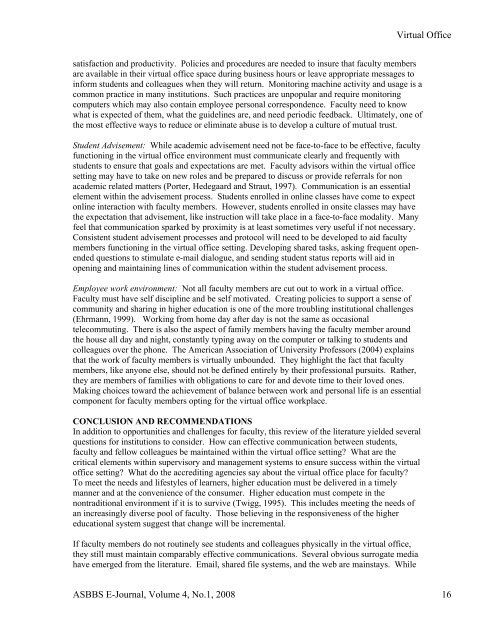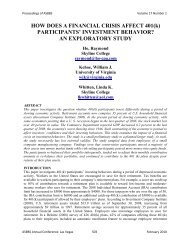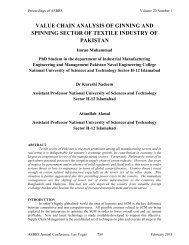stock repurchase announcements: a test of market ... - Asbbs.org
stock repurchase announcements: a test of market ... - Asbbs.org
stock repurchase announcements: a test of market ... - Asbbs.org
Create successful ePaper yourself
Turn your PDF publications into a flip-book with our unique Google optimized e-Paper software.
satisfaction and productivity. Policies and procedures are needed to insure that faculty members<br />
are available in their virtual <strong>of</strong>fice space during business hours or leave appropriate messages to<br />
inform students and colleagues when they will return. Monitoring machine activity and usage is a<br />
common practice in many institutions. Such practices are unpopular and require monitoring<br />
computers which may also contain employee personal correspondence. Faculty need to know<br />
what is expected <strong>of</strong> them, what the guidelines are, and need periodic feedback. Ultimately, one <strong>of</strong><br />
the most effective ways to reduce or eliminate abuse is to develop a culture <strong>of</strong> mutual trust.<br />
Student Advisement: While academic advisement need not be face-to-face to be effective, faculty<br />
functioning in the virtual <strong>of</strong>fice environment must communicate clearly and frequently with<br />
students to ensure that goals and expectations are met. Faculty advisors within the virtual <strong>of</strong>fice<br />
setting may have to take on new roles and be prepared to discuss or provide referrals for non<br />
academic related matters (Porter, Hedegaard and Straut, 1997). Communication is an essential<br />
element within the advisement process. Students enrolled in online classes have come to expect<br />
online interaction with faculty members. However, students enrolled in onsite classes may have<br />
the expectation that advisement, like instruction will take place in a face-to-face modality. Many<br />
feel that communication sparked by proximity is at least sometimes very useful if not necessary.<br />
Consistent student advisement processes and protocol will need to be developed to aid faculty<br />
members functioning in the virtual <strong>of</strong>fice setting. Developing shared tasks, asking frequent openended<br />
questions to stimulate e-mail dialogue, and sending student status reports will aid in<br />
opening and maintaining lines <strong>of</strong> communication within the student advisement process.<br />
Employee work environment: Not all faculty members are cut out to work in a virtual <strong>of</strong>fice.<br />
Faculty must have self discipline and be self motivated. Creating policies to support a sense <strong>of</strong><br />
community and sharing in higher education is one <strong>of</strong> the more troubling institutional challenges<br />
(Ehrmann, 1999). Working from home day after day is not the same as occasional<br />
telecommuting. There is also the aspect <strong>of</strong> family members having the faculty member around<br />
the house all day and night, constantly typing away on the computer or talking to students and<br />
colleagues over the phone. The American Association <strong>of</strong> University Pr<strong>of</strong>essors (2004) explains<br />
that the work <strong>of</strong> faculty members is virtually unbounded. They highlight the fact that faculty<br />
members, like anyone else, should not be defined entirely by their pr<strong>of</strong>essional pursuits. Rather,<br />
they are members <strong>of</strong> families with obligations to care for and devote time to their loved ones.<br />
Making choices toward the achievement <strong>of</strong> balance between work and personal life is an essential<br />
component for faculty members opting for the virtual <strong>of</strong>fice workplace.<br />
CONCLUSION AND RECOMMENDATIONS<br />
In addition to opportunities and challenges for faculty, this review <strong>of</strong> the literature yielded several<br />
questions for institutions to consider. How can effective communication between students,<br />
faculty and fellow colleagues be maintained within the virtual <strong>of</strong>fice setting? What are the<br />
critical elements within supervisory and management systems to ensure success within the virtual<br />
<strong>of</strong>fice setting? What do the accrediting agencies say about the virtual <strong>of</strong>fice place for faculty?<br />
To meet the needs and lifestyles <strong>of</strong> learners, higher education must be delivered in a timely<br />
manner and at the convenience <strong>of</strong> the consumer. Higher education must compete in the<br />
nontraditional environment if it is to survive (Twigg, 1995). This includes meeting the needs <strong>of</strong><br />
an increasingly diverse pool <strong>of</strong> faculty. Those believing in the responsiveness <strong>of</strong> the higher<br />
educational system suggest that change will be incremental.<br />
If faculty members do not routinely see students and colleagues physically in the virtual <strong>of</strong>fice,<br />
they still must maintain comparably effective communications. Several obvious surrogate media<br />
have emerged from the literature. Email, shared file systems, and the web are mainstays. While<br />
Virtual Office<br />
ASBBS E-Journal, Volume 4, No.1, 2008 16

















